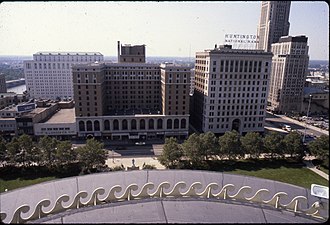Huntington National Bank Building
| Huntington National Bank Building | |
|---|---|
 East (main) facade on High Street | |
 | |
| General information | |
| Architectural style | Second Renaissance Revival |
| Location | Columbus, Ohio |
| Address | 17 South High Street |
| Coordinates | 39°57′42.01″N 83°0′3.74″W / 39.9616694°N 83.0010389°WCoordinates: 39°57′42.01″N 83°0′3.74″W / 39.9616694°N 83.0010389°W |
| Completed | 1926 |
| Height | 168 ft (51 m) |
| Technical details | |
| Floor count | 13 |
| Design and construction | |
| Architect | |
The Huntington National Bank Building is a bank and office building on Capitol Square in Downtown Columbus, Ohio. Once the headquarters to the Huntington National Bank, it now includes the company's primary lending bank, the Capitol Square Branch. It is part of the Huntington Center complex, which also contains the Huntington Center skyscraper, Huntington Plaza, and DoubleTree Hotel Guest Suites Columbus.
The building envelops the twelve-story Harrison Building at 21 South High Street, built in 1903. Huntington Bank's offices moved there from their old building nearby, at the southwest corner of Broad and High, in 1916. In 1925, with limited space for the quickly-growing bank, it built around the Harrison Building, incorporating it into the significantly larger Huntington National Bank Building. The original southern facade of the Harrison Building is still visible from High Street.[1][2]
The building was designed by in the Second Renaissance Revival style. The main, east-facing facade uses fine-grained limestone, with a large central entranceway, multiple belt course, and decorative cornice. The style matches the new building with the old Harrison Building. During construction of the Huntington Center next-door, the architect, added a modern stucco pattern to the 1926 building's then-plain brick west facade, mirroring its east facade.[2]
The building features a large banking lobby, taking up most of the first floor. The room features original banking counters, tellers' cages, decorated ceiling, and intricate elevator doors.[2]
Gallery[]

The Harrison Building c. 1907

Huntington Bank building by the Neil House hotel in the 1980s

The bank building in the early 20th century
References[]
- ^ "A Historical Guidebook to Old Columbus: Finding the Past in the Present in ... - Bob Hunter - Google Books". Google.com. Retrieved 2020-05-17.
- ^ a b c Darbee, Jeffrey T.; Recchie, Nancy A. (2008). The AIA Guide to Columbus. Ohio University Press. ISBN 9780821416846.
External links[]
| Wikimedia Commons has media related to Huntington National Bank Building. |
- Office buildings in Columbus, Ohio
- Commercial buildings completed in 1926
- Huntington Bancshares
- 1926 establishments in Ohio
- Office buildings completed in 1926
- Bank buildings in Columbus, Ohio
- Buildings in downtown Columbus, Ohio
- Columbus, Ohio building and structure stubs



